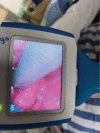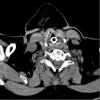The difficult removal of tracheal tube after general anesthesia: A case report
- PMID: 36221343
- PMCID: PMC9542731
- DOI: 10.1097/MD.0000000000030968
The difficult removal of tracheal tube after general anesthesia: A case report
Abstract
Background: Laryngeal injury is common after endotracheal intubation, presenting with varying degrees of edema, ulceration, granulation, and limited vocal cord movement, usually resulting in lumen narrowing. In these cases, laryngeal edema is a common complication after intubation, usually caused by direct pressure and inflammatory reaction caused by endotracheal intubation on the contact surface.
Case presentation: A 71-year-old female was scheduled to undergo open reduction and internal fixation of femoral neck. On admission, she was diagnosed with femoral neck fracture. Tracheal intubation induced by general anesthesia was successful, but the tracheal catheter was difficult to remove after the operation. After 2 days of detumescence in ICU, the extubation was successful under the condition of complete recovery of spontaneous breathing.
Conclusions: Patients undergoing general anesthesia may have laryngeal or glottic edema due to operation time, operation and other reasons, resulting in difficulty in extubation after general anesthesia. The extubation action shall be gentle. In case of obvious resistance, it shall not be forcibly extubated to prevent serious dyspnea after extubation.
Copyright © 2022 the Author(s). Published by Wolters Kluwer Health, Inc.
Conflict of interest statement
The authors have no funding and conflicts of interest to disclose.
Figures



Similar articles
-
[Case of laryngeal edema occurring after tracheal extubation presumably due to antihypertensive medications].Masui. 2009 May;58(5):626-8. Masui. 2009. PMID: 19462804 Japanese.
-
Laryngeal morbidity after tracheal intubation: the Endoflex(®) tube compared to conventional endotracheal intubation with stylet.Acta Anaesthesiol Scand. 2013 Jul;57(6):737-44. doi: 10.1111/aas.12079. Epub 2013 Feb 5. Acta Anaesthesiol Scand. 2013. PMID: 23379725 Clinical Trial.
-
[Severe laryngeal edema after tracheal extubation--report of a case].Masui. 2001 Nov;50(11):1236-8. Masui. 2001. PMID: 11758333 Japanese.
-
Laryngeal Injury and Upper Airway Symptoms After Endotracheal Intubation During Surgery: A Systematic Review and Meta-analysis.Anesth Analg. 2021 Apr 1;132(4):1023-1032. doi: 10.1213/ANE.0000000000005276. Anesth Analg. 2021. PMID: 33196479 Free PMC article.
-
[Negative pressure pulmonary edema: report of case series and review of the literature].Braz J Anesthesiol. 2019 Mar-Apr;69(2):222-226. doi: 10.1016/j.bjan.2018.11.005. Epub 2018 Dec 24. Braz J Anesthesiol. 2019. PMID: 30591273 Free PMC article. Review.
References
-
- Darmon JY, Rauss A, Dreyfuss D, et al. . Evaluation of risk factors for laryngeal edema after tracheal extubation in adults and its prevention by dexamethasone. A placebo-controlled, double-blind, multicenter study. Anesthesiology. 1992;77:245–51. - PubMed
-
- Cavallone LF, Vannucci A. Review article: extubation of the difficult airway and extubation failure. Anesth Analg. 2013;116:368–83. - PubMed
-
- Ajith Kumar AK, Cascella M. Post intubation laryngeal edema. 2021 Jul 17. In: StatPearls [Internet]. Treasure Island, FL: StatPearls Publishing. 2021. - PubMed
Publication types
MeSH terms
LinkOut - more resources
Full Text Sources

